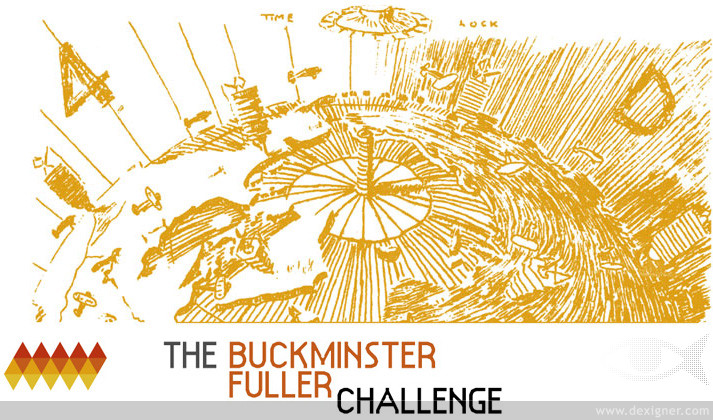My first exposure to design inspired by Buckminster Fuller came in 1967 at EXPO in Montreal. The American Pavilion occupied a geodesic dome crisscrossed by escalators and elevated trams. It was magical, architecture on a grand scale that inspired.
Fuller died in 1983 but he has continued to inspire through an institute named after him and the annual international design challenge it sponsors. This year’s winner will receive $100,000, with the money to be used to further develop and implement a program or technology that helps humanity to solve recognized planetary problems.
The Challenge which has been operating for six years has seen a record number of entries in 2013 and 19 have made it to the semifinals. The list includes:
- Loowatt – a waterless toilet that is clean, odor free, and produces energy and fertilizer as byproducts, and has received international recognition already through a $1 million grant from the Bill & Melinda Gates Foundation.
- OurSOIL – with SOIL an acronym for Sustainable Organic Integrated Livelihoods, an integrated ecological sanitation project developed in Haiti for converting human waste to compost with the goal, the restoration of soils degraded by deforestation and runoff.
- Ecovative Design – a high-performance packaging biomaterial made from mushrooms that is an alternative to plastic and styrofoam and is 100% compostable.
- Public Laboratory for Open Technology and Science – an open-source online collaborative research website that includes a spectrum of environmental data gathering activities and that encourages freely-shared technology development.
- Abellon CleanEnergy – a Gujarat, India, producer of solid biofuels including biomass pellets made from waste as well as clean energy and power generation exchange mechanism.Other products include Eco-Chulha, a community eco-friendly biomass burning cooking stove.
- Green Empowerment – a Nicaraguan low carbon project providing renewable energy, water conservation and forest preservation to villages and communities.
- Tarun Bharat Sangh – an initiative in India to restore river and degraded ecosystems in arid areas of the country by building rainwater harvesting systems and facilitating recharging of groundwater sources.
- The Green Chemistry Commitment– promoting green chemistry understanding, chemistry that focuses on environmental impact at the earliest stages of invention and innovation, in U.S. colleges, universities and businesses.
- IBJ (International Bridges to Justice) – training public defenders globally to protect human rights by training lawyers on how to conduct criminal defense and protect client rights.
- Voltree Power – a company that has developed a bioenergy harvester as well as innovative acoustic sensors that filter out background noise in the environment to identify distinct sounds and vibrations made by insect larvae considered to be agricultural and forestry pests.
- 100,000 Homes – a campaign to house 100,000 homeless in the United States by July 2014.
- Fundacion Paraguay “Traffic Light” Strategy – identifying the world’s poor to prioritize programs for the extremely poor (red light), poor (yellow light), and not poor (green light) and coming up with strategies for poverty elimination including education and financing instruments such as micro-credits.
- Echale a tu Casa – producing housing for the poor in Mexico through innovations in construction technology and finance.
- MDLabs – designing and constructing better buildings that reflect social and cultural environmental characteristics of places like Haiti to restore the infrastructure devastated by the 2010 earthquake.
- Build Change – a Colombian initiative to design earthquake-resistant housing and provide homeowners, builders, engineers and government with the training, technical and financial assistance to build them.
- PITCHAfrica Waterbank School – focused on education to train and teach Kenyans to develop water harvesting systems and materials that capture rainfall and are socially and culturally acceptable.
- Ento – an initiative to address global food demand by introducing insects into diets as a modern, healthy food source.
- Olazul – a non-profit initiative in California that is revolutionizing shrimp farming to restore ocean ecosystems.
- Cooperafloresta – a Brazilian initiative to develop in-forest agriculture that combines modern technology with traditional local knowledge to build holistic and sustainable production of crops that increase the value of what is produced and the income of local families.
Contests, crowdfunding, and micro-loans and credits – these are among the many non-traditional financial instruments exploding upon the scene here in the 21st century. These instruments more and more are taking the place of charity and loan guarantees from foreign governments. For the most part they address socially responsible projects to lift communities and individuals out of poverty, and build the necessary infrastructure and educational resources to accelerate positive change.
For all of these Buckminster Fuller Challenge semi-finalists they will be measured against the performance standards and criteria established by a team of judges who will be looking at the following commitments and competencies before choosing a winner:
- Visionary – that the project puts forth an original idea creatively addressing critical needs or synthesizing existing ideas to develop new strategies.
- Comprehensive — that the project is holistic in all facets of its design and implementation process while simultaneously addressing root causes and multiple goals.
- Anticipatory — that the project factors in critical future trends and needs as well as projected impacts for the short and long term.
- Ecologically responsible — that the project is eco-friendly and sustainable.
- Feasible — that the project is based on current technology and existing resources supported by a strong implementation team.
- Verifiable — that the project can be measured and tested and meet its goals.
- Replicable — that the project is capable of being adapted to other localities experiencing similar issues and conditions.










